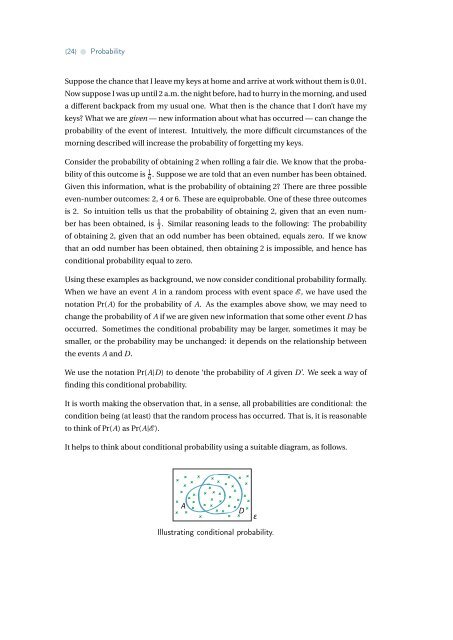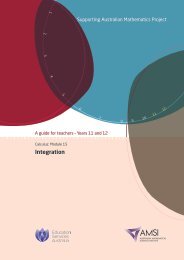Probability - the Australian Mathematical Sciences Institute
Probability - the Australian Mathematical Sciences Institute
Probability - the Australian Mathematical Sciences Institute
- No tags were found...
You also want an ePaper? Increase the reach of your titles
YUMPU automatically turns print PDFs into web optimized ePapers that Google loves.
{24} • <strong>Probability</strong>Suppose <strong>the</strong> chance that I leave my keys at home and arrive at work without <strong>the</strong>m is 0.01.Now suppose I was up until 2 a.m. <strong>the</strong> night before, had to hurry in <strong>the</strong> morning, and useda different backpack from my usual one. What <strong>the</strong>n is <strong>the</strong> chance that I don’t have mykeys? What we are given — new information about what has occurred — can change <strong>the</strong>probability of <strong>the</strong> event of interest. Intuitively, <strong>the</strong> more difficult circumstances of <strong>the</strong>morning described will increase <strong>the</strong> probability of forgetting my keys.Consider <strong>the</strong> probability of obtaining 2 when rolling a fair die. We know that <strong>the</strong> probabilityof this outcome is 1 6. Suppose we are told that an even number has been obtained.Given this information, what is <strong>the</strong> probability of obtaining 2? There are three possibleeven-number outcomes: 2, 4 or 6. These are equiprobable. One of <strong>the</strong>se three outcomesis 2. So intuition tells us that <strong>the</strong> probability of obtaining 2, given that an even numberhas been obtained, is 1 3. Similar reasoning leads to <strong>the</strong> following: The probabilityof obtaining 2, given that an odd number has been obtained, equals zero. If we knowthat an odd number has been obtained, <strong>the</strong>n obtaining 2 is impossible, and hence hasconditional probability equal to zero.Using <strong>the</strong>se examples as background, we now consider conditional probability formally.When we have an event A in a random process with event space E , we have used <strong>the</strong>notation Pr(A) for <strong>the</strong> probability of A. As <strong>the</strong> examples above show, we may need tochange <strong>the</strong> probability of A if we are given new information that some o<strong>the</strong>r event D hasoccurred. Sometimes <strong>the</strong> conditional probability may be larger, sometimes it may besmaller, or <strong>the</strong> probability may be unchanged: it depends on <strong>the</strong> relationship between<strong>the</strong> events A and D.We use <strong>the</strong> notation Pr(A|D) to denote ‘<strong>the</strong> probability of A given D’. We seek a way offinding this conditional probability.It is worth making <strong>the</strong> observation that, in a sense, all probabilities are conditional: <strong>the</strong>condition being (at least) that <strong>the</strong> random process has occurred. That is, it is reasonableto think of Pr(A) as Pr(A|E ).It helps to think about conditional probability using a suitable diagram, as follows.û ûûû û û ûû ûûû ûû ûûûû û û ûûû ûû ûû û û ûA ûûû û û ûû û û û Dû û ûεIllustrating conditional probability.
















